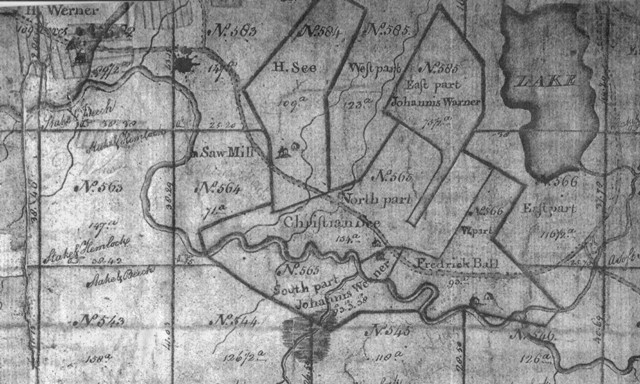1787 survey map

About 1785 Stephen Van Rensselaer III hired William Cockburn to survey his Helderberg wilderness in preparation for signing leases with the squatters living there in the valleys, and for leasing the still vacant land in the hills. The resulting 1787 survey map shows roads, churches, mills, and streams, gives the lot number and name of each leaseholder.
Cockburn first surveyed the lots of the squatters along the boundaries of the land that they were actually farming including their wood lots. In the area that now includes the Towns of Berne and Knox there were about 90 irregularly shaped lots, indicating that they had been settled prior to the survey. The homesteads of the squatters were concentrated along the Switzkill and Foxenkill valleys, with other scattered farms to the east along what is now the Helderberg Trail (State Route 443). Farther north there were farms in a broad swath along the route through Knox between Altamont and Schoharie. This appears to have been the main road through the hill country. Here and there among the farms were vacant lots for which no leases had yet been issued. There were no hamlets. Van Rensselaer immediately forced the squatters to either sign leases or abandon their homesteads.
The map shows unbroken wilderness in the rugged hills above the Switzkill and Foxenkill valleys, and in the northern half of what is now the Town of Knox. This vacant land was surveyed into uniform, rectangular lots for leasing. In what is now Knox the lots were 120-acres each reflecting the relatively better and leveler land than to the south in what is now Berne where the lots were a half mile on each side and contained 160 square acres.
New settlers were recruited from the over-crowded and already-depleted farms of New England and downstate. Handbills were distributed announcing veterans of the Revolution would receive homesteads without cost. Only after the farms became productive would there be any compensation. The conditions of the grants stated that a farmer must clear the land, build a dwelling, and live there for seven years before beginning to pay rent.
In studying Cockburn's map it is clear that Knox was settled before Berne. The reason for this earlier settlement was its location along the only trail into the Schoharie Valley from Albany which the original Palatine settlers had cleared in 1712. The survey map shows along both sides of the trail through Knox a broad swath of irregularly shaped lots. From the surnames it is apparent that these early settlers were German immigrants, some of whom had originally settled in Schoharie to the west, plus a few Dutch settlers who had come from the east over the Helderberg escarpment. While there is a crossroad shown at what is now the hamlet of Knox, there was no community.
The northern half of the map is of Berne and Knox. The southern half of the map is of Rensselaerville and Westerlo. The map is in the NYS Library Manuscripts and Special Collections Division in Albany. In the 1930s or 40s they made what they call "photostats" of the original map.
The photostat copies of the northern half of the map is on 14 sheets. Basically it is 3 sheets wide and 4 sheets high for the first two rows, and 5 sheets wide for the southern two rows. The southern half map is divided into two sets, SE and SW. The SE set of photostats includes all of Westerlo and eastern third of Rensselaerville. The SW set of photostats includes the rest of Rensselaerville. Each of these two sets consists of 12 sheets; 3 sheets wide and 4 sheets high.
When I (Hal Miller) was at the NYS Library the end of June, 2009, I made used my digital camera to make a digital image of each sheet for all three sets. I then cropped the images and enhanced them to the best of my limited ability. Click the links below to see the images of the maps.
- Portion of map which is now the town of Berne.
- Portion of map which is now the town of Knox.
- Portion of map which is now the town of Westerlo and eastern third of what is now the town of Rensselaerville.
- Portion of map which is now the Town of Rensselaerville.